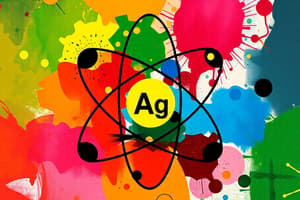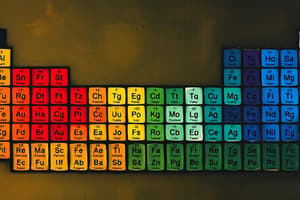Podcast
Questions and Answers
What happens to atomic radius as you move from left to right across a period?
What happens to atomic radius as you move from left to right across a period?
- It varies randomly
- It remains the same
- It increases
- It decreases (correct)
Which group of elements is highly reactive and tends to gain one electron to form a -1 ion?
Which group of elements is highly reactive and tends to gain one electron to form a -1 ion?
- Alkali metals
- Halogens (correct)
- Noble gases
- Alkaline earth metals
What happens to ionization energy as you move from top to bottom within a group?
What happens to ionization energy as you move from top to bottom within a group?
- It remains the same
- It increases
- It varies randomly
- It decreases (correct)
Which group of elements loses two electrons to form a +2 ion?
Which group of elements loses two electrons to form a +2 ion?
What happens to electron affinity as you move from left to right across a period?
What happens to electron affinity as you move from left to right across a period?
Which group of elements is unreactive and does not easily gain or lose electrons?
Which group of elements is unreactive and does not easily gain or lose electrons?
What is the primary reason for the decrease in electron gain enthalpy as you move down a group?
What is the primary reason for the decrease in electron gain enthalpy as you move down a group?
Which of the following statements is true about the valence electrons of an atom?
Which of the following statements is true about the valence electrons of an atom?
What is the primary difference between metals and nonmetals in terms of their electron behavior?
What is the primary difference between metals and nonmetals in terms of their electron behavior?
Which of the following subshells has a specific capacity of 6 electrons?
Which of the following subshells has a specific capacity of 6 electrons?
What is the term for the energy change when an electron is added to a neutral atom in the gaseous state?
What is the term for the energy change when an electron is added to a neutral atom in the gaseous state?
Which group of elements exhibits some properties of both metals and nonmetals?
Which group of elements exhibits some properties of both metals and nonmetals?
What is the primary factor that contributes to the increase in ionization energy from left to right across a period?
What is the primary factor that contributes to the increase in ionization energy from left to right across a period?
Which type of chemical reaction involves the combination of two or more substances to form a new compound?
Which type of chemical reaction involves the combination of two or more substances to form a new compound?
What is the effect of increasing surface area on the rate of a chemical reaction?
What is the effect of increasing surface area on the rate of a chemical reaction?
Which of the following statements is true about atomic radius trends?
Which of the following statements is true about atomic radius trends?
What is the effect of a catalyst on a chemical reaction?
What is the effect of a catalyst on a chemical reaction?
Which of the following statements is true about electronegativity trends?
Which of the following statements is true about electronegativity trends?
Flashcards are hidden until you start studying
Study Notes
Periodic Trends
- Atomic Radius: Decreases from left to right across a period, increases from top to bottom within a group
- Electronegativity: Increases from left to right across a period, decreases from top to bottom within a group
- Ionization Energy: Increases from left to right across a period, decreases from top to bottom within a group
- Electron Affinity: Increases from left to right across a period, decreases from top to bottom within a group
Element Groups
- Alkali Metals (Group 1):
- Highly reactive
- Lose one electron to form a +1 ion
- Include lithium (Li), sodium (Na), potassium (K), etc.
- Alkaline Earth Metals (Group 2):
- Less reactive than alkali metals
- Lose two electrons to form a +2 ion
- Include magnesium (Mg), calcium (Ca), strontium (Sr), etc.
- Halogens (Group 17):
- Highly reactive
- Gain one electron to form a -1 ion
- Include fluorine (F), chlorine (Cl), bromine (Br), etc.
- Noble Gases (Group 18):
- Unreactive
- Do not easily gain or lose electrons
- Include helium (He), neon (Ne), argon (Ar), etc.
Ionization Energy
- Definition: Energy required to remove an electron from an atom
- Trends:
- Increases from left to right across a period
- Decreases from top to bottom within a group
- Factors affecting ionization energy:
- Nuclear charge
- Electron shielding
- Distance of electron from nucleus
Electron Gain Enthalpy (Electron Affinity)
- Definition: Energy change when an electron is added to an atom
- Trends:
- Increases from left to right across a period
- Decreases from top to bottom within a group
- Factors affecting electron gain enthalpy:
- Nuclear charge
- Electron shielding
- Distance of electron from nucleus
Studying That Suits You
Use AI to generate personalized quizzes and flashcards to suit your learning preferences.




